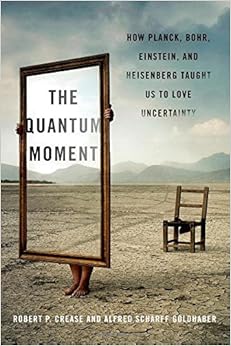By Amir Alexander, The New York Times, February 16, 2015
“On or about September 1927,” wrote the philosopher Ray Monk, “the physical world changed.” Until then, according to Robert P. Crease and Alfred Scharff Goldhaber’s rich and entertaining new book, “The Quantum Moment,” we lived in a homogeneous, continuous, Newtonian world in which all objects moved seamlessly from the past to the future, governed by universal mathematical laws.
But in that fateful year, everything changed: Objects now follow different rules depending on their size, and we can never be sure where they are or what they are doing.
In fact, we can’t even say what they are, because that depends on how we observe them. Our reality became one of unpredictable “gaps, inconsistencies, warps and bubbles,” as John Updike put it, and we are still struggling to find our way in the quantum universe.
Dr. Crease is a philosopher and Dr. Goldhaber a physicist at Stony Brook University, and their book is an introduction to the brave new world we inhabit. The harmony of the Newtonian universe, they argue, began to fray in 1900, when Max Planck discovered that to correctly describe “black box” radiation, he had to make a radical and unwarranted assumption: that light radiation was not continuous, but came in discrete and irreducible packets of a fixed size, or quantum.
Classical physicists believed the discontinuous quantum was a mere computational trick, but rather than fade away as expected, the mysterious energy packets started popping up in more and more places. In 1905, Einstein demonstrated that the quantum explained the photoelectric effect and the strange phenomenon known as Brownian motion. Some years later, a young Niels Bohr came up with a model of the atom in which electrons moved between specified “orbits” when they absorbed or emitted energy quanta. The unwelcome interloper, it seemed, was here to stay.
For Newtonian physics, much worse was to come. From 1925 to 1927, quantum mechanics moved from challenging the contents of classical physics to undermining its deepest foundations. It was during those intense years that Werner Heisenberg proposed his uncertainty principle, which posited that the location and momentum of particles could not both be known with certainty at the same time. Almost simultaneously Erwin Schrödinger proposed his psi function, which describes the probability that a particle will be found in a given location in terms of a wave, which in turn led Bohr to formulate his complementarity principle: An object can be a wave or a particle depending on how it is measured. The location and momentum of an object, and even whether it is a wave or a particle, was no longer a free-standing fact of nature. It depended on the act of observation.
Dr. Crease and Dr. Goldhaber make these mind-boggling theories plausible to the lay reader, but their focus is on the cultural implications of the quantum revolution. What can one make of a world in which particles move seemingly as they please, where a particle can also be a wave, and measurement can affect its location, momentum and even what it is? And how does that change how we see the world?
Clearly the new science has given rise to a new way of experiencing the world. Updike, the authors point out, likened reconstructions of John F. Kennedy’s assassination to the indeterminacy of subatomic particles; the artist Antony Gormley created series of sculptures exploring how form takes shape through randomness; a character in Teju Cole’s novel “Open City” perceives the illusion of life’s continuity.
And some of those nearest to the storm made more sweeping claims. Already in 1928, the famed British astronomer Arthur Eddington argued that the indeterminacy of the quantum universe opened the way for the reintroduction of the spiritual into the world, initiating a line of thinking that associates the paradoxes of the quantum world with the mysteries of religion. Some years later, the American physicist Arthur H. Compton argued that the quantum world pointed to the existence of God; in the 1970s, the Fundamental Fysiks Group related quantum mechanics to New Age Eastern mysticism.
For Dr. Crease and Dr. Goldhaber, however, the significance of the moment lies elsewhere. Quantum mechanics changed the world not by reintroducing spiritualism into science but by extinguishing the dream of perfect determinism and mathematical predictability that structured the Newtonian universe.
Yet that dream is far older than Newton: Already in the sixth century B.C., Pythagoras and his disciples claimed that everything in the world could be described by whole numbers and their ratios, and more than two millenniums later, Descartes made a powerful case for a perfectly rational and mathematically knowable universe. Each time, however, the rigorous scheme fell victim to the forces of disorder: The Pythagoreans had their “quantum moment” when they discovered irrational numbers, which proved the hopelessness of their quest; Descartes’s followers were felled by Newton’s discovery of universal gravity.
The quantum revolution may well have changed our world, as Dr. Crease and Dr. Goldhaber argue. But it may not have been the unique turning point that they make it to be. It was, quite possibly, just the latest encounter in a long struggle pitting the human advocates of mathematics and order against an unruly world that seems to keep its deepest mysteries to itself.
Amir Alexander is the author of “Infinitesimal: How a Dangerous Mathematical Theory Shaped the Modern World.”

No comments:
Post a Comment